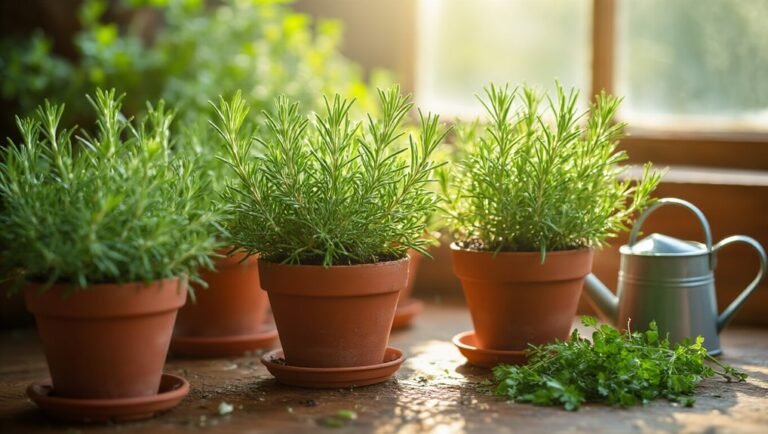You must test the pH of your hydroponic system to ensure your plants absorb nutrients effectively. The right pH level, between 5.5 and 6.5, promotes healthy growth and nutrient availability. Without regular checks, you risk nutrient deficiencies or toxicities, which can lead to yellowing leaves and stunted growth. To keep your plants thriving, establish a routine for monitoring pH levels. Discover how you can maintain optimal conditions for your plants’ success in the next sections.
Key Takeaways
- Regular pH testing ensures nutrient availability, crucial for healthy plant growth in hydroponic systems.
- pH imbalances can lead to nutrient deficiencies or toxicities, negatively impacting plant health.
- Monitoring pH helps identify early signs of issues such as yellowing leaves or stunted growth.
- Maintaining the optimal pH range of 5.5 to 6.5 promotes effective nutrient absorption for optimal plant performance.
- Consistent pH adjustments prevent nutrient lockout, supporting overall plant vitality and resilience against pests and diseases.
Understanding Ph and Its Importance in Hydroponics
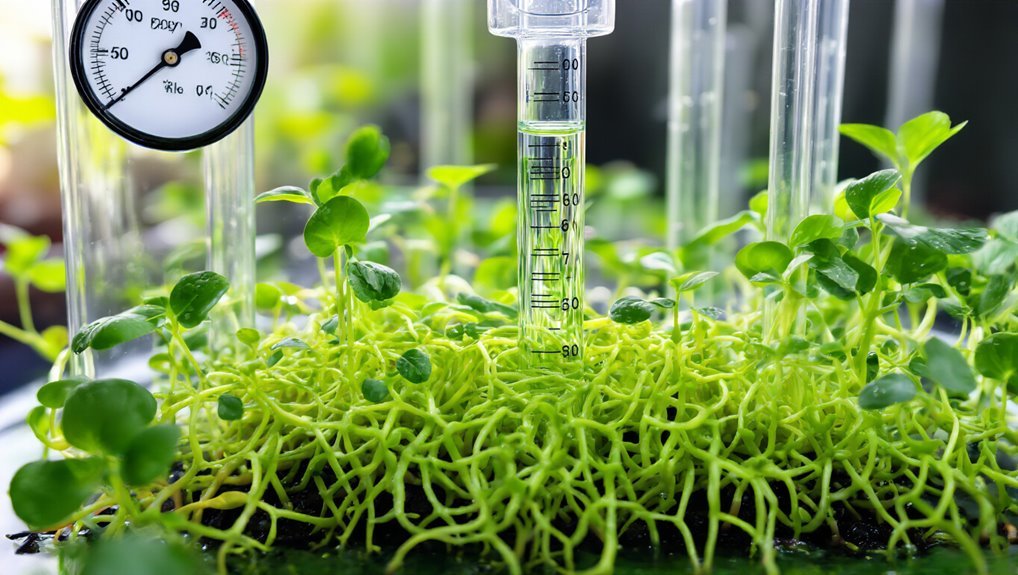
Understanding pH is crucial in hydroponics because it directly affects nutrient availability and plant health. When you maintain the right pH level, you’re ensuring that your plants can absorb essential nutrients effectively. If the pH is too high or too low, your plants may struggle to thrive, leading to deficiencies or toxicities. Regularly checking the pH helps you identify any imbalances before they become problematic. Using hydroponic gardening systems can make it easier to monitor and adjust these levels for optimal plant growth. You’ll want to aim for a pH range of 5.5 to 6.5 for most hydroponic systems. Additionally, fluctuations in pH can occur due to various factors, like nutrient changes or plant uptake.
To support healthy growth, it’s important to use hydroponic nutrient solutions specifically formulated for optimal plant performance in a controlled environment.
The Impact of Ph on Nutrient Availability
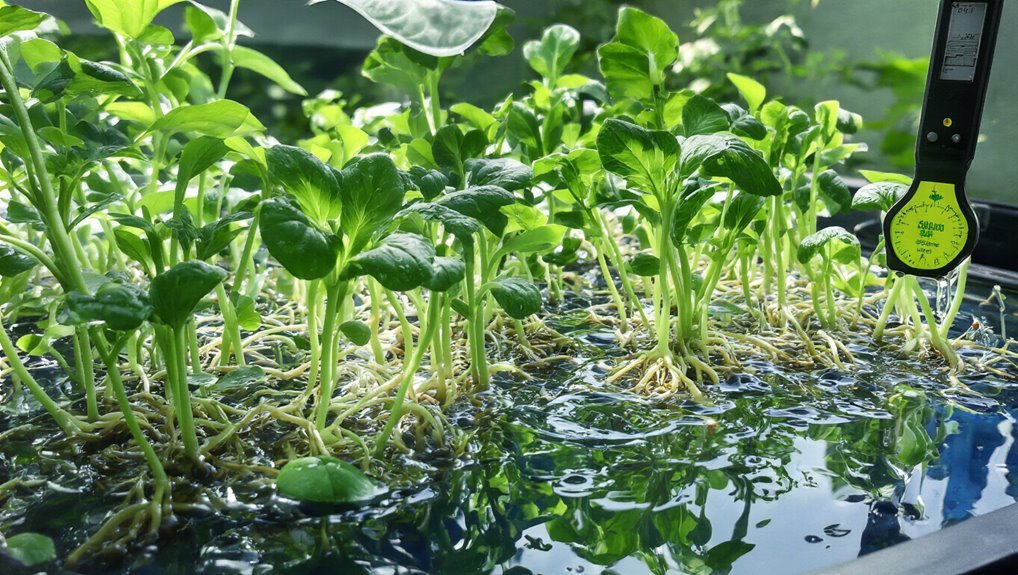
When the pH level of your hydroponic system falls outside the optimal range, it can significantly impact nutrient availability for your plants.
Each nutrient has a specific pH range in which it’s most accessible to the plant roots. For instance, if the pH is too high or too low, essential nutrients like nitrogen, phosphorus, and potassium may become locked out. If you’re just starting out with hydroponics, using a seed starting kit can help establish healthy seedlings that are ready to thrive in your system.
This means your plants won’t absorb them effectively, leading to nutrient deficiencies. You might notice stunted growth or yellowing leaves as a result.
To ensure your plants thrive, regularly test and adjust the pH levels in your system. Maintaining the right pH not only enhances nutrient uptake but also promotes overall plant health and productivity.
Using plant fertilizer tablets can further boost your garden by providing essential nutrients, especially when used alongside proper pH management.
Signs of Ph Imbalance in Your Hydroponic System
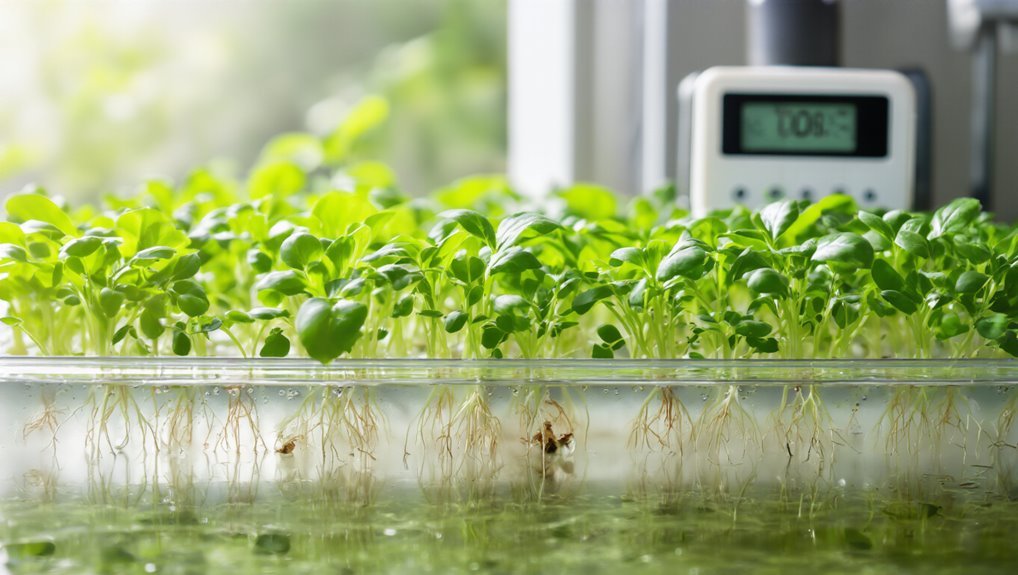
If you notice your plants showing signs of distress, it might be due to a pH imbalance in your hydroponic system.
Look out for yellowing leaves, especially on older foliage, as this could indicate nutrient deficiencies. You might also see stunted growth or wilting, which suggests your plants aren’t absorbing nutrients effectively. Monitoring temperature with a compost thermometer can also be helpful, as temperature fluctuations may impact nutrient uptake and pH stability.
Dark green leaves with a curled appearance can signal a nutrient lockout caused by improper pH levels. Additionally, if your plants develop brown spots or edges, it’s another warning sign.
Pay attention to overall plant vigor; unhealthy plants may become more susceptible to pests and diseases. Regularly monitoring these signs can help you maintain a thriving hydroponic environment.
Don’t ignore these cues—act quickly to restore balance!
Using the right plant food options can also help prevent nutrient deficiencies and support optimal plant health in your hydroponic system.
How to Test the Ph of Your Nutrient Solution
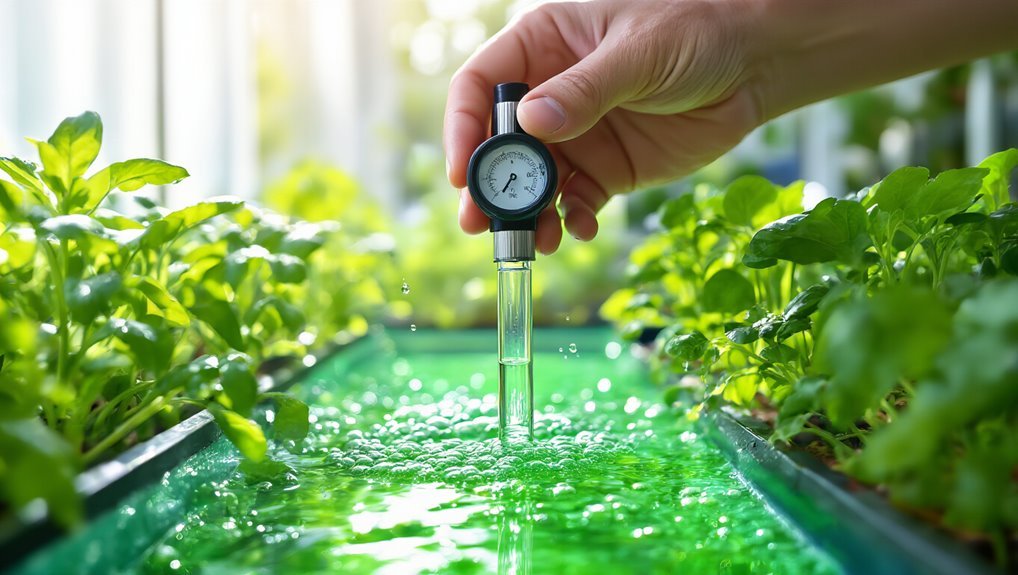
Testing the pH of your nutrient solution is essential for keeping your hydroponic system healthy and productive.
Start by gathering a pH meter or pH test kit, both of which are widely available. If you’re using a pH meter, calibrate it according to the manufacturer’s instructions for accuracy.
Next, take a sample of your nutrient solution in a clean container. Insert the pH meter’s probe into the solution or follow the kit’s instructions to use the test strips. Incorporating a drip irrigation system can also help deliver your nutrient solution more efficiently and consistently to your plants.
Wait for the reading to stabilize, and note the pH level. Ideally, your nutrient solution should fall between 5.5 and 6.5.
Regular testing ensures that you can maintain optimal conditions for your plants’ growth and nutrient absorption. For even better results in hydroponics or soil gardening, consider using soil moisture sensors to monitor overall plant health and maintain balanced growing conditions.
Adjusting Ph Levels: Methods and Best Practices
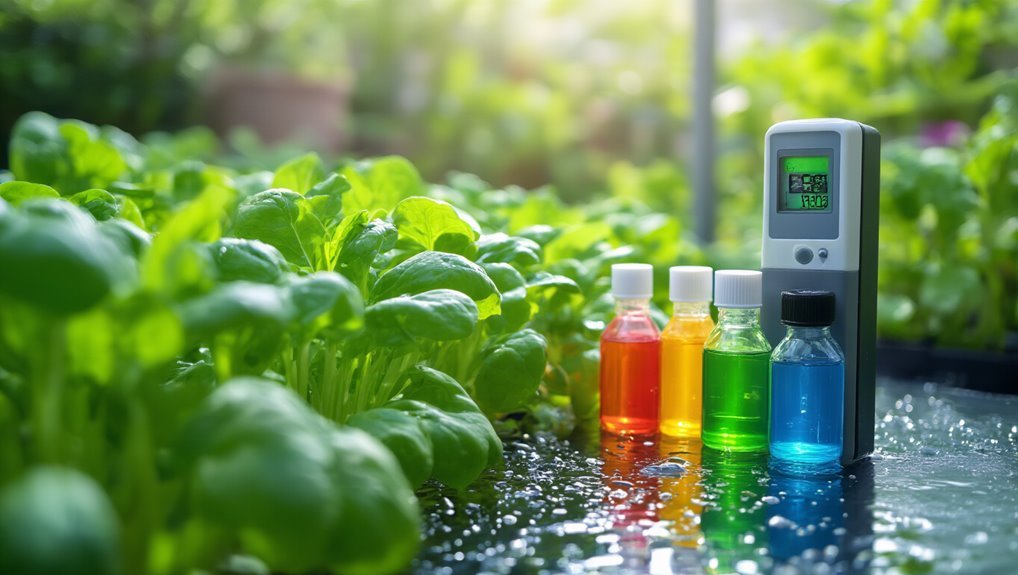
Maintaining the right pH level in your nutrient solution isn’t just about testing; it’s also about knowing how to adjust those levels when needed.
Here are some effective methods and best practices to keep your system balanced:
- Use pH Up and pH Down Solutions: These are specifically designed for hydroponics and can quickly adjust your pH levels.
- Monitor Regularly: Check your pH at least once a week to catch fluctuations early.
- Dilute Your Solutions: If your pH is too high, adding distilled water can help bring it down gradually.
- Stay Consistent: Stick to a routine for adjustments to maintain a stable environment for your plants.
The Role of Ph in Preventing Nutrient Deficiencies
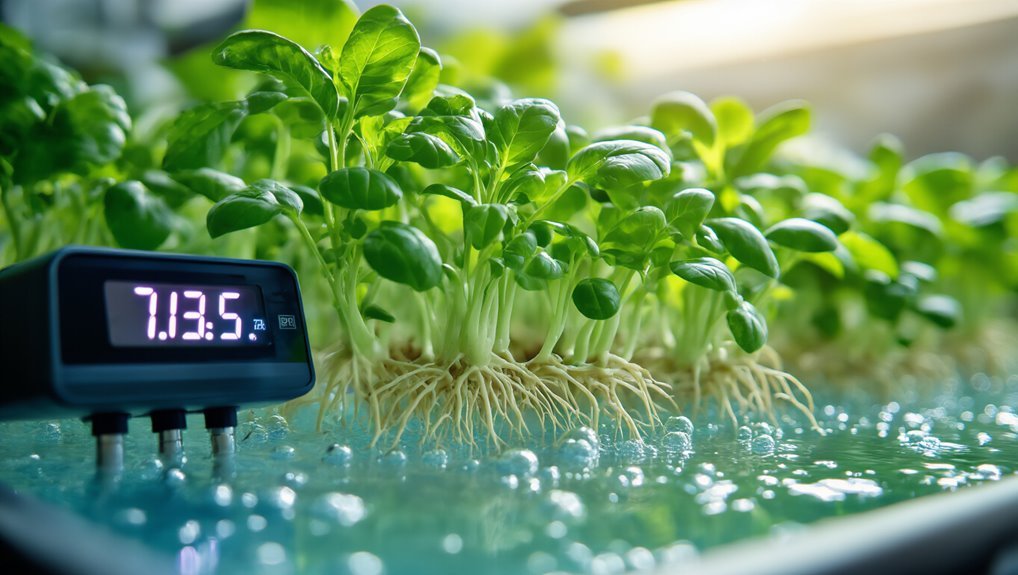
Ensuring your hydroponic system has the right pH level is crucial for preventing nutrient deficiencies that can hinder plant growth. A balanced pH allows plants to absorb essential nutrients efficiently. If your pH is too high or too low, you might notice signs of deficiency, such as yellowing leaves or stunted growth. Here’s a quick reference table to help you understand how pH levels affect nutrient availability:
| pH Level | Nutrient Availability | Signs of Deficiency |
|---|---|---|
| 5.5-6.5 | Optimal for most nutrients | Healthy growth, vibrant leaves |
| Below 5.5 | Iron, Manganese deficiencies | Yellowing leaves, weak stems |
| Above 6.5 | Calcium, Magnesium deficiencies | Leaf curling, poor fruit development |
Monitoring your pH regularly can keep your plants thriving!
Maintaining Optimal Ph for Maximum Plant Growth
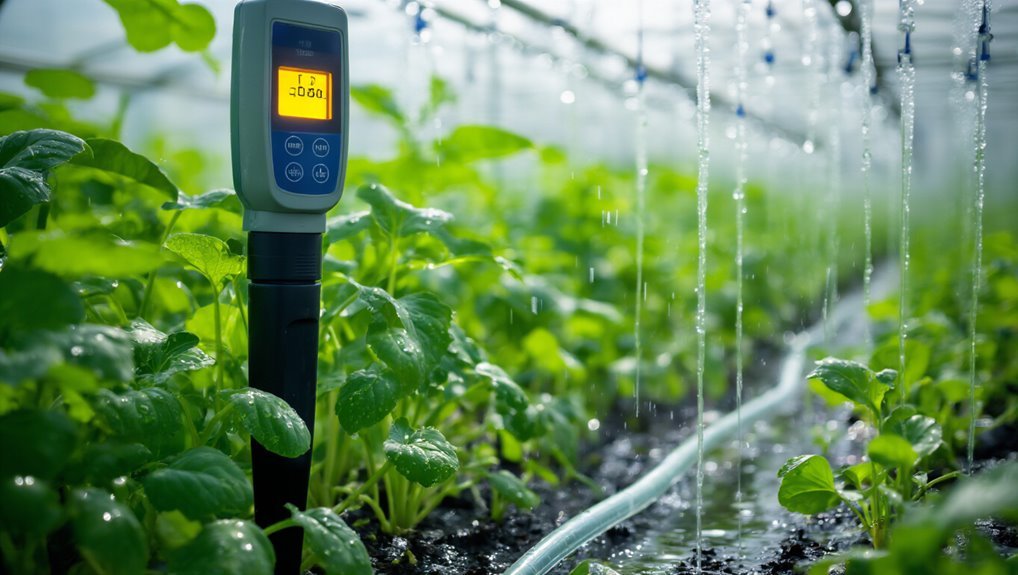
Achieving the right pH level is key to maximizing plant growth in hydroponics. When you maintain optimal pH, your plants thrive, and you reap the rewards of a bountiful harvest.
Here are four reasons why you should prioritize pH management:
- Enhanced Nutrient Absorption: Proper pH ensures your plants can uptake essential nutrients effectively, leading to healthier growth.
- Stronger Plants: Balanced pH promotes robust root systems, making plants more resilient to disease and stress.
- Increased Yields: Healthy plants produce more fruit or flowers, boosting your overall yield and satisfaction.
- Cost Efficiency: Preventing nutrient deficiencies means fewer wasted resources and lower overall costs.
Stay proactive with your pH testing, and watch your hydroponic garden flourish!
Frequently Asked Questions
How Often Should I Test the Ph in My Hydroponic System?
You should test the pH in your hydroponic system at least once a week. However, if you notice any issues with plant growth, it’s best to check more frequently to ensure optimal conditions.
Can Ph Affect the Growth Rate of My Plants?
Imagine lush, vibrant plants reaching for the sky. Yes, pH can significantly affect your plants’ growth rate. A balanced pH ensures nutrients are available, helping your plants thrive and flourish in their hydroponic environment.
What Ph Level Is Optimal for Different Plant Species?
Different plant species thrive at varying pH levels. Generally, most vegetables prefer a pH between 6.0 and 7.0, while herbs often like slightly acidic conditions around 6.0. Always adjust for your specific plants’ needs.
Are There Any Natural Methods to Adjust Ph Levels?
A stitch in time saves nine; you can use natural methods to adjust pH levels. Adding vinegar lowers pH, while baking soda raises it. Always test after adjustments to ensure your plants thrive.
Can Ph Testing Equipment Be Reused or Calibrated?
Yes, you can reuse pH testing equipment, but you should periodically calibrate it for accuracy. Regular calibration ensures your readings remain reliable, helping you maintain optimal conditions in your hydroponic system effectively.
Conclusion
In hydroponics, keeping your pH in check is vital for thriving plants. Did you know that even a slight pH shift—just 0.5 units—can reduce nutrient uptake by up to 50%? By regularly testing and adjusting your pH levels, you can prevent nutrient deficiencies and ensure your plants get what they need to grow strong. So, make pH testing a priority in your hydroponic system; it’s a small effort that leads to big rewards in your garden’s health!
